
SA BEATITUDE MAR IGNACE PIERRE VIII ABDEL AHAD -- PATRIARCHE SYRIEN D’ANTIOCHE

- Né à Alep (Syrie) le 28 juin 1930. Son père Abdel Karim et sa mère Eugénie Tashash - Ayant fait ses études primaires dans une école paroissiale, il répondit à l’appel du Seigneur et entra au petit séminaire des pères bénédictins à Jérusalem, le 13.10.1944. - Le 6 juillet 1948, il a dû quitter Jérusalem à cause de la guerre arabo-israelienne pour continuer ses études secondaires philosophiques et théologiques au séminaire syrien catholique de Charfet (Liban) - Le 17 octobre 1954, il fut ordonné prêtre avec neuf autres de ses confrères par l’imposition des mains de son Éminence le Patriarche Ignace Gabriel Tappouni en la Cathédrale Saint-Georges à Beyrouth. - De 1955 à 1965, il servit au séminaire de Charfet en qualité d’économe, de professeur et d’administrateur. Durant cette période, il fut nommé aumônier de la Confrérie de l’Immaculée Conception et renouvela l’édition du «Dalil Al-Hadi», un livre de messe et de prières en arabe. - En 1965, il fut nommé curé de la paroisse Saint-Joseph de Bethléem, directeur de l’école paroissiale et assistant pour les communautés syriennes catholiques de Palestine et de Jordanie. - En 1979, il fut nommé Vicaire Patriarcal de Jérusalem et ordonné Chorévèque la même année. - En 1996, il fut élu par le Saint Synode des évêques syriens catholiques, évêque de Jérusalem et de Terre Sainte. Sa consécration épiscopale eut lieu à Alep, le 21 juin 1997, par l’imposition des mains de Sa Béatitude Mar Ignace Antoine II Hayek. - Il continua à s’acquitter de ses responsabilités pastorales et spirituelles auprès de ses fidèles et de tous ceux qui l’approchaient, avec zèle et dévouement, surtout auprès des prisonniers de guerre et des réfugiés à la suite des événements tragiques de 1962 et 1973. - Il réalisa aussi plusieurs projets d’ordre éducatif et social au profit des paroissiens et des pèlerins, comme la maison Saint-Joseph pour les enfants et un foyer de pèlerins à Bethléem, ainsi que l’église Saint-Thomas, un centre de jeunes et un foyer de pèlerins à Jérusalem. Il prépara aussi la construction d’une église et d’un presbytère à Amman en Jordanie. - A part l’arabe et le syriaque, il parle le français, l’anglais et l’italien. - Le 16 février 2001, il a été élu Patriarche des Syriens Catholiques par le Synode des évêques, réuni à Charfet (Liban), succédant ainsi au Patriarche Moussa Daoud, nommé Préfet de la Congrégation pour les Églises Orientales à Rome. - Le 25 février 2001 aura lieu son intronisation en la Cathédrale de l’Annonciation à Beyrouth.
His Beatitude The Patriarch GREGORIUS III LAHHAM -- Greek Melkite Patriarch of Antioch and all the East and Alexandria and Jerusalem
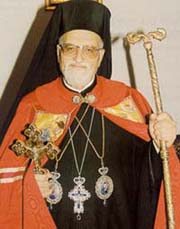
His Beatitude Gregory III Laham Patriarch of Antioch and all the East His Beatitude was born in 1933 at Daraya (near Damascus, capital of Syria), known as the site of Christ’s apparition to St. Paul. In 1943, the young Lutfi (it means “gentile”) entered the seminary of the Salvatorian fathers at St. Savior Monastery near Saida (south Lebanon) where he finished his philosophical and theological studies. He presented his religious temporary vows in 15 August 1949 and the perpetual vows in 20 January 1952. His supiriors sent him to Rome (Italy) in 1956 to further his theological studies. In 1961, he was granted the Doctorate degree in Oriental Ecclesiastical Studies from the Pontifical Oriental Institute directed by the Jesuit fathers. During his stay in Rome, he was ordained priest in 1959 at the Monastery of Grottaferrata (near Rome). Back to Lebanon, he was appointed in 1961 rector of the Major Seminary of his Order in St. Savior Monastery, relocated later in Jeita (near Beirut), charge accomplished until the year 1969. At the mean time, he was teaching Theology and Liturgy at the Major Seminary and the University of Holy Spirit in Kaslik (near Beirut). Moved by the Spirit to the work for the unity of the Church, he founded in 1962 the review “Unity in Faith”. It was the first Arabic review treating of Oriental and Ecumenical questions and problems. Thus, the holy Synod of the Melkite Catholic Church appointed him Secretary of the Ecumenical Commission and the Liturgical Commission. He was the, in 1972, able to prepare in Beirut, the first Liturgical Congress common to both Greek Orthodox and Catholic Churches of Antioch. More than that, he was zealous in pursuing and favoring the Dialogue and Relations between the two churches. He gained later on the sympathy of both Orthodox and Catholic and was member in the ATIME (= Association of Theological Institutes in Middle East). Thus, he was invited to give lectures and participate in Theological congresses either in Germany, Italy, London… These charges did not stop the dynamic priest to work and serve many and different parishes where he devoted himself to preaching and teaching either in Lebanon and Syria. He was then able to undertake many social activities creating the ambulant centers of “The Young Girl” in 1965 in the Diocese of Saida. Then, with the help of many German friends, and the Salvatorian fathers George Koueiter and Salim Ghazal, he undrtook the realization of the social project of “ The Providence Center for Boys” at Salhieh (near Saida). This center is a multifunctional center comprehending a house for 100 youngsters orphans, a technical school for about 500 students, and a center for the Young people directed towards parish, social and religious activities. At the same time, he proposed in 1971 to open a center for”Religious Studies” for adults. In fact, more than 20 people chose then to serve the Lord in the Priesthood. In 1974, with the arrest of Archbishop Hilarion Capucci by the Israeli Authorities, His Beatitude Patriarch Maximos V appointed him Patriarcal General Vicar of the Melkite Greek Catholic Patriarcate in Jerusalem. There in Jerusalem, between the years 1974-1975, he finished the projects undertaken there, wich include the restoration of the patriarcal residence, embellishment of the cathedral with frescoes and of the adjacent pilgrim’s hostel. Once again, he devoted his energies to the religious studies creating a special center for them. This center became nowadays a branch to the University of Bethlehem granting the License degree. He added to this center, in 1976, the Oriental Library which includes many books in different languages, thus giving the opportunities to pilgrams to know about the Eastern Churches Tradition. From 1977 on, he consecrated lot of his energies in social works, thus creating the “Financial Chest” to provide help for needy students of Jerusalem to pursure their studies. The Holy Synod, in his meeting of 9 September 1981, elected him bishop. He was consecrated in Damascus in 27 November of the same year by H.B. Patriarch Maximos V, assisted by H.E. Archbishops Saba Youakim and Francis Abou Mokh. At the same year, he initiated the work for a housing project formed of 36 apartments for the needy families of Jrusalem, with a church, a social hall and a health center. The project was terminated in 1983. Since then, he did not stop to further his social activities in constructing houses, schools, restoring churches, health centers… further housing projects are ongoing! In 1986, the Holy Synod appointed him as head of the Synofal and Patriarchal Liturgical Commission. He vigorously worked with the Liturgical Commission ti finish in 1992 the book of the “Devine Liturgy”, adding to the old edition many different introductions and variations. He is still caring to finish the book of the “Liturgical Prayers” in 5 Volumes. This kind of books makes our Church be proud of its Byzantine Tradition. Besides these two very important projects, His Beatitude is profilic in many writings and in different languages such “ Introduction to the liturgical rites and their symbols in the Eastern Church”, “Voice of the Pastor”, “Germanos Adam”, “History of the Melkite Church”, “Melkite Church in Vatican II Council”,… In June 2000, he invited all the Catholic Archbishops of the Byzantine Churches from Eastern Europe and the Diaspora for a Convention in the Patriarchate Residence in Jerusalem. They studied together the common problems to their Churches. It was the first meeting of his kind among the different Byzantine Churchrs. H.B. Maximos V, due to his bad health, resigned of his many important responsabilities as head of the Melkite Greek Catholic Church. The Holy Synod met at Raboueh, patriarchal residence in Lebanon, on 22 November 2000 to accept the resignation of the Patriarch. On 29 November 2000, the Holy Synod elected Archbishop Lutfi Patriarch of Antioch and all the East, of Alexandria and of of Jerusalem. He took the name of Gregorios III. The Greek name Gregory means the “vigilant”
His Beatitude Cardinal Mar Nasrallah Boutros Sfeir Maronite Patriarch of Antioch and all the East
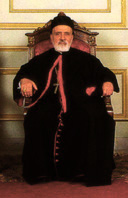
He is the 3rd Maronite Cardinal and the 76th Patriarch of the Maronite Church.
Born in Rayfoun, Kesrouan, the 15 May 1920 Primary and Complementary studies at Mar Abda School - Harharaya.
Secondary studies at St. Maron Seminary - Ghazir. Philosophical and Theological studies at St. Joseph University of Beirut (Licensed in Philosophy and Theology) sfeir Publications (in Arabic language) 1. Of the sources of the Gospel, Bkerke, 1975,416p. 2. Personalities that disappeared from 1961 - 1974 in 2 volumes, Bkerke, 1984 3. Sunday Sermons: spiritual reflections and stand of national positions, many volumes, Bkerke, 1988.... 7 May 1950 Ordained Priest 1951-1955 Priest of Rayfoun Parish. In charge of the secretariat of the Maronite Bishopric of Damascus. 1956 Secretary of the Maronite Patriarchate - Bkerke. Professor of translation in literature and philosophy at the Freres Maronite School - Jounieh. 19 June 1961 Titular bishop of Tarse and Patriarchal Vicar. 3 July 1961 Confirmation of his election by His Holiness Pope John XXIII. 16 July 1961 Ordained Bishop 1961-1986 Patriarchal Vicar and Secretary of the Maronite Patriarchate. 19 April 1986 Elected Maronite Patriarch for Antioch and all the East. 7 May 1986 His Holiness Pope John Paul II entrusted him the "ecclesiastic communio" . 26 November 1994 Created Cardinal by His Holiness Pope John Paul II. 1995 Delegate President of the Special Assembly of the Synod of Bishops for Lebanon.
HIS BEATITUDE MICHEL SABBAH
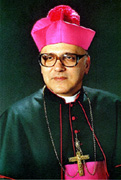
LATIN PATRIARCH OF JERUSALEM
Publication 1988 "First pastoral letter" the faith in the Holy Land" 1990 Second pastoral letter "Ask for the peace for Jerusalem" on the Intifada and the voice of the Church and the Christians. 1991 Third pastoral letter for the centenary of father Youssef Tannous, of the patriarchal clergy, founder of the Nuns of the Rosary. 1992 Lent letter on Emigration 1993 Fourth pastoral letter " Read the Bible in the land of the Bible" Born at Nazareth on the 19th of March 1933 Began his studies at the Latin Patriarchal Seminary of Beit Jala in (Bethlehem) in October 1949. Ordained priest at Nazareth on the 29th of June 1955. 1955 Curate in the parish of Madaba (Jordan) 1957 Teacher of arabic at the Latin Patriarchal Seminary of Beit Jala (Bethlehem) 1959 Studies of Arab philology at the University St. Joseph Beirut-Lebanon 1964 Responsible of the youth in the latin patriarchal diocese of Jerusalem 1966 Director of the Schools in the patriarchal diocese of Jerusalem 1968 Djibouti, Africa (teacher of arabic and islamology to the european staff) 1970 Priest at the parish Christ - Roi, Amman Jordan 1973 Support of his thesis of doctor in arab philology at the Sorbone 1980 President of the University of Bethlehem 1987 Latin Patriarch of Jerusalem
Fonte : Opus Libani
IGREJA MARONITA DO BRASIL
Eparquia é uma palavra grega que significa diocese. A Eparquia Maronita no Brasil existe desde 1962. O primeiro bispo maronita no Brasil foi Dom Francis Zayek. Eleito no dia 30 de maio de 1962, foi consagrado no dia 5 de agosto de 1962. Foi o primeiro bispo nomeado para a diáspora, fora do Patriarcado maronita no Oriente Médio. Chegou ao Brasil, tomou posse estabelecendo sua sede em São Paulo. No dia 10 de março de 1966 foi transferido para os Estados Unidos e nomeou como vigário geral, o monsenhor Antônio Joubeir que administrou a diocese até a chegado do novo bispo, Dom João Chedid em 1968. Dom João Chedid já era bispo e exercia a função de vigário geral do Patriarca maronita no Líbano. Sua nomeação como bispo do Brasil aconteceu no dia 1º. de março de 1968. Estes dois bispos, Zayek e Chedid, foram exarcos, isto é, bispos maronitas auxiliares do Ordinário dos Orientais católicos no Brasil, o arcebispo do Rio de Janeiro. No dia 29 de novembro de 1971, o exarcado maronita do Brasil foi erigido à eparquia ou diocese autônoma. Nestas condições o bispo ou eparca é titular e o ordinário da diocese. Dom João Chedid renunciou em 1990 por motivo de idade avançada e estado precário de saúde, vindo a falecer no Líbano no dia 30 de Julho de 1991. Dom Zayek atualmente está aposentado ou bispo emérito nos Estados Unidos. O terceiro bispo maronita do Brasil atualmente é Dom Joseph Mahfouz. Foi eleito no dia 9 de junho de 1990 e consagrado no dia 12 de agosto de 1990, no Patriarcado do Líbano. Chegou ao Brasil no dia 6 de outubro de 1990, tomando posse no dia 21 do mesmo mês.
( Fonte : Igreja Maronita do Brasil )
HIS BEATITUDE NERSES BEDROS XIX
Patriarch of the Catholic Armenians
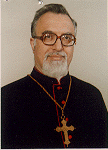
Born in Cairo Egypt on the 17th January 1940
He is the 5th of a family of 8 children.
He completed his primary and secondary studies at the College of the “Brothers of Christian Schools” (Frères des Ecoles Chrétiennes) in Cairo.
He felt the vocation to priesthood very early in life and thus was sent to the “Armenian Leonian Pontifical College of Rome” in 1958 where he studied Philosophy and Theology at the “Pontifical Gregorian University”.
His Bishop Msgr. Raphael Bayan ordained him priest in Cairo on The 15th August 1965. He served the parish of the Catholic Armenian Cathedral of the Annunciation in Cairo from 1965 to 1968 with the Rev. Father Jean Kasparian who became Patriarch Catholicos under the name of Jean Pierre XVIII in 1982.
From 1968 to 1990 he was curate of the parish of St. Therese of Heliopolis (Cairo) where he encouraged the various religious movements, especially the Neo-Catechumenal Way. On the 18th February 1990, he was ordained bishop of the Eparchy (Diocese) of Alexandria for Egypt and Sudan by the imposition of the hands of His Beatitude Jean Pierre XVIII. During six years, from 1992 to 1997, as member of the Catholic Hierarchy of Egypt, he was the General Secretary of the Pastoral Council of the Catholic Church of Egypt.
As a member of the Synod of the Bishops of the Catholic Armenian Patriarch Church, he was successful in being:
Member of the Council of the three Bishops to direct the Patriarchal Curie from 1993 to 1995.· President of the Patriarchal Commission for the Vocations from 1993 to 1995. Member of the Permanent Synod as of 1994. In October 1999, he was elected by the Bishops of the Holy Synod of the Catholic Armenian Synod, Patriarch Catholicos of Cilice for the Catholic Armenians and took the name of Nerses Bedros XIX.
H.B. Stephanos II GHATTAS, C.M.
The Coptic-Catholic Patriarch of Alexandria
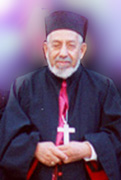
Patriarca Caldeu da Babilônia
O patriarca caldeu da Babilônia é Emmanuel-Karim Delly, representante da comunidade cristã no Iraque , sucedendo sua beatitude Raphael I Bidawid . Foi nomeado novo patriarca da Babilônia no dia 2 de dezembro de 2003 , por um Sínodo celebrado em Roma pelos Bispos da Igreja caldéia, que reconhece a autoridade do Papa. À cerimônia, que foi realizada na Catedral de São José, no centro de Bagdá, assistiram o Núncio de Sua Santidade, Cardeal Fernando Velloni, e os chefes das Igrejas Armênia, Ortodoxa e Síria no Iraque. Deste modo, estavam presentes várias autoridades políticas e dignitários religiosos.
____________________________________________________O Patriarca é um bispo eleito em Sínodo , reconhecido pelo direito eclesiástico , a ele compete uma honra singular (singulari honore prosequendi sunt), com ampla jurisdição sobre seu Patriarcado. O Patriarca é um arcebispo que possui uma espécie de "primado" sobre os bispos de seu patriacado. Os patriarcas da Igreja Católica são feitos cardeais pelo Papa , logo após as suas respectivas indicações .
EPARQUIA - Na antiguidade Greco-romana , Eparquia significava prefeitura, província e o Eparca Prefeito. Designa , em termos religiosos , a diocese ( do CDC latino ). Existem três eparquias no Brasil : (1) Eparquia de Nossa Senhora do Líbano, com sede em São Paulo , rito Maronita; (2) Eparquia de Nossa Senhora do Paraíso , São Paulo , rito Melquita; (3) Eparquia de São João Batista , Curitiba , rito Ucraniano.
EXARCADO - Segundo o Direito Oriental é uma circunscrição eclesiástica em formação. Os Exarcas são bispos que representam Patriarca. Os Exarcas tem jurisdição sobre o Exarcado Apostólico , que no direito canônico oriental corresponde a uma circunscrição eclesiástica que está fora do território Patriarcal e que não foi ainda constituído Eparquia (diocese) por motivo de um baixo número de fiéis ou outro motivo. O Exarcado Apostólico corresponde à Administração Apostólica São Paulo é a sede do Exarcado Apostólico Armênio da América Latina, para os fiéis de rito Armênio.
Na Igreja Católica Oriental , segundo o direito expresso no Motu próprio "Cleri Sanctitati" (1957), o Arcebispo Maior é unido a uma Sé Metropolitana que está fora de um Patriarcado determinado, e este é reconhecido pelo Pontífice Romano e pelo Concilio Ecumênico ; o Arcebispo Maior possui direitos similares aos de um Patriarca.
Arquimandrita: O título Arquimandrita, no passado correspondia ao Superior de um Mosteiro , sinônimo de Abade (Higumeno). Atualmente é um título de honra eclesiástica auferido a um sacerdote conforme suas responsabilidades dentro da Igreja. Corresponde ao titulo de Monsenhor da Igreja latina.
Protossincelo: Título honorífico auferido a um sacerdote da Igreja Oriental, e segundo o novo Direito Canônico Oriental, é o Vigário Geral da Diocese (cf. Cano 245-251).
______________________________________________Melquita
___________________________________________________________Ao contrário das outras igrejas católicas do Oriente , a Igreja Melquita não é uma igreja nacional , mas uma igreja dispersa , com fiéis por todo o Oriente Médio . Ela pertence à tradição litúrgica bizantina .
_______________________________________________________A estruturação da Igreja na Antiguidade -- a Pentarquia
________________________________________________________Under Justinian, imperial authority and the rights of the Patriarchs were consolidated. The Novella 123(3) set the order of precedence of the Patriarchal Seats as follows: Rome, Constantinople, Alexandria, Antioch and Jerusalem. Furthermore, the consecration of metropolitan bishops and the convening of local councils would remain with the Patriarchs, as well as judicial rights and the right of control over the entire Patriarchate and that of dispatching personal ambassadors to other Patriarchates. In addition, the Patriarchs were granted the right to maintain a permanent Synod, a union of Bishops, to carry out and direct the main business of the Patriarchate. The Pentarchy, which was virtually tantamount to a government by five territorial Popes, one of whom, the Pope of Rome, had universal primacy, collapsed in 1054 with the schism of Constantinople. Centuries earlier, at the time of the Ecumenical Council of Chalcedony in 451, the Patriarchate of Antioch had undergone a severe crisis which led to a split in the Patriarchate itself. This crisis had been created by the Dyophysitic definition (4). The Monophysites, who acknowledge only one person in Christ, were condemned by the Council. They persisted in holding to their doctrine principally for political, anti-byzantine motives, since the emperor had become the Guarantor of the "orthodox" doctrine. To challenge the Council of Chalcedony signified a form of protest against imperial authority, against Constantinople. The term "Melchgite" (5) was thus coined to refer to the true believers, those who remained faithful to the Council doctrine and who followed imperial orthodoxy. The "orthodox" Patriarchate of Antioch has been called "Melkite" ever since. The same occurred in Alexandria (6) and the Patriarch and the faithful who accepted the official doctrine were called "Melkites". With the schism between Constantinople and Rome in 1054 the entire East virtually broke away from the West and the Eastern Patriarchates, up to that time in close contact with Rome, mostly rallied round the ideas of the Ecumenical Patriarch of Constantinople. In order, however, to distinguish themselves from the heretics, whom they had always condemned and repudiated, the Church of the East, though now separated from Rome, insisted on calling themselves "orthodox", that is to say faithful to the true doctrine just as, in order to stress the universal character of its Primacy, the Holy See of Rome called itself "Catholic". Thus, in time, "orthodox" came to be applied to Christians belonging to a Church of the East that had broken away from Catholicism.
_______________________________________Diocleciano e Teodósio
(1) In the year 292, Diocletian had divided the empire into 12 "Diocesess". In 395, Theodosius had decreed the division into the Eastern and Western empires, each which were divided into "Provinces". According to the "Notitia dignilatam" the Roman Empire around the end of the 4th century thus consisted of: The Empire of the East with the eastern Prefecture, comprising the "Dioceses" of Egypt (capital Alexandria) East (Antioch), Asia (Ephesus), Thrace (Heraclea) Pontus and the Prefecture of llliria with the two "Dioceses" and Macedonia, the Empire of the West with the Italian Prefecture, comprising the Italian, African and Illyrican Prefectures and the Prefecture of Gaul with the "Dioceses" of Spain, Gaul and Britain.